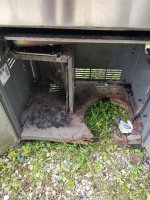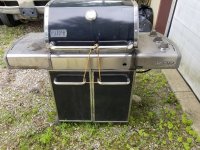RobW-ToolmakerRob
TVWBB Member
Hi Everyone,
Fairly new to this forum but have done many bbq repairs over the years, mostly on Vermont Castings units as I find it relaxing working on things such as this and seeing them come back to life. Recently I happened to pick up a Genesis EP310 for free. It had a rusted out bottom plate where the tank would sit but two hours in the machine shop where I work and I had a new one made out of stainless angle iron and 14 gage stainless plate and made myself some new flavoriser bars out of 16 gage stainless as well. After a good cleaning it looks like new!! I may buy a new set of burners too. Only wish it had a side burner as I use one quite often when cooking. Was totally impressed with the build quality of this unit. I also was just given a Q1000 with a stand so I guess I am officially hooked!!!
Is there somewhere on these forums that explains the history of the different models and when they were introduced and what options were available? I seem to get confused with hearing about different models such as Genesis/1000/Silver/Platinum etc. Just looking for some insight.
Thanks in advance,
Rob
Fairly new to this forum but have done many bbq repairs over the years, mostly on Vermont Castings units as I find it relaxing working on things such as this and seeing them come back to life. Recently I happened to pick up a Genesis EP310 for free. It had a rusted out bottom plate where the tank would sit but two hours in the machine shop where I work and I had a new one made out of stainless angle iron and 14 gage stainless plate and made myself some new flavoriser bars out of 16 gage stainless as well. After a good cleaning it looks like new!! I may buy a new set of burners too. Only wish it had a side burner as I use one quite often when cooking. Was totally impressed with the build quality of this unit. I also was just given a Q1000 with a stand so I guess I am officially hooked!!!
Is there somewhere on these forums that explains the history of the different models and when they were introduced and what options were available? I seem to get confused with hearing about different models such as Genesis/1000/Silver/Platinum etc. Just looking for some insight.
Thanks in advance,
Rob





